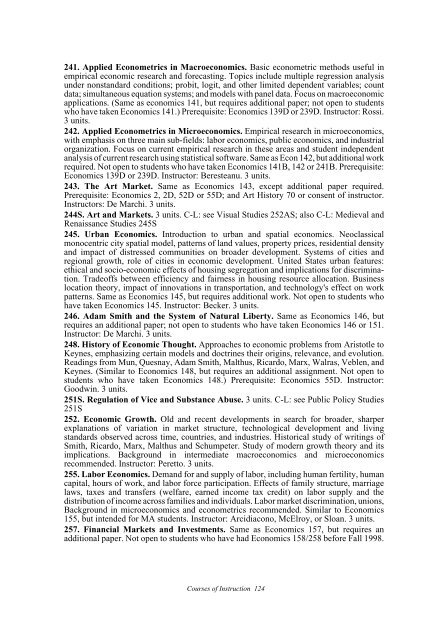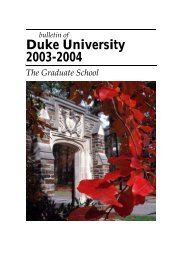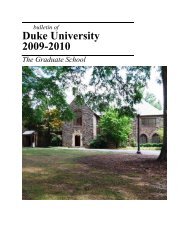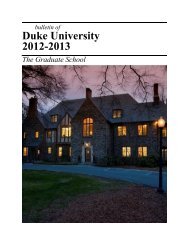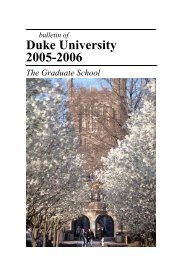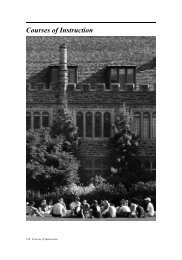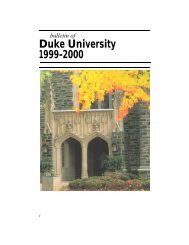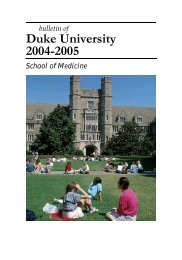Duke University 2008-2009 - Office of the Registrar - Duke University
Duke University 2008-2009 - Office of the Registrar - Duke University
Duke University 2008-2009 - Office of the Registrar - Duke University
Create successful ePaper yourself
Turn your PDF publications into a flip-book with our unique Google optimized e-Paper software.
241. Applied Econometrics in Macroeconomics. Basic econometric methods useful in<br />
empirical economic research and forecasting. Topics include multiple regression analysis<br />
under nonstandard conditions; probit, logit, and o<strong>the</strong>r limited dependent variables; count<br />
data; simultaneous equation systems; and models with panel data. Focus on macroeconomic<br />
applications. (Same as economics 141, but requires additional paper; not open to students<br />
who have taken Economics 141.) Prerequisite: Economics 139D or 239D. Instructor: Rossi.<br />
3 units.<br />
242. Applied Econometrics in Microeconomics. Empirical research in microeconomics,<br />
with emphasis on three main sub-fields: labor economics, public economics, and industrial<br />
organization. Focus on current empirical research in <strong>the</strong>se areas and student independent<br />
analysis <strong>of</strong> current research using statistical s<strong>of</strong>tware. Same as Econ 142, but additional work<br />
required. Not open to students who have taken Economics 141B, 142 or 241B. Prerequisite:<br />
Economics 139D or 239D. Instructor: Beresteanu. 3 units.<br />
243. The Art Market. Same as Economics 143, except additional paper required.<br />
Prerequisite: Economics 2, 2D, 52D or 55D; and Art History 70 or consent <strong>of</strong> instructor.<br />
Instructors: De Marchi. 3 units.<br />
244S. Art and Markets. 3 units. C-L: see Visual Studies 252AS; also C-L: Medieval and<br />
Renaissance Studies 245S<br />
245. Urban Economics. Introduction to urban and spatial economics. Neoclassical<br />
monocentric city spatial model, patterns <strong>of</strong> land values, property prices, residential density<br />
and impact <strong>of</strong> distressed communities on broader development. Systems <strong>of</strong> cities and<br />
regional growth, role <strong>of</strong> cities in economic development. United States urban features:<br />
ethical and socio-economic effects <strong>of</strong> housing segregation and implications for discrimination.<br />
Trade<strong>of</strong>fs between efficiency and fairness in housing resource allocation. Business<br />
location <strong>the</strong>ory, impact <strong>of</strong> innovations in transportation, and technology's effect on work<br />
patterns. Same as Economics 145, but requires additional work. Not open to students who<br />
have taken Economics 145. Instructor: Becker. 3 units.<br />
246. Adam Smith and <strong>the</strong> System <strong>of</strong> Natural Liberty. Same as Economics 146, but<br />
requires an additional paper; not open to students who have taken Economics 146 or 151.<br />
Instructor: De Marchi. 3 units.<br />
248. History <strong>of</strong> Economic Thought. Approaches to economic problems from Aristotle to<br />
Keynes, emphasizing certain models and doctrines <strong>the</strong>ir origins, relevance, and evolution.<br />
Readings from Mun, Quesnay, Adam Smith, Malthus, Ricardo, Marx, Walras, Veblen, and<br />
Keynes. (Similar to Economics 148, but requires an additional assignment. Not open to<br />
students who have taken Economics 148.) Prerequisite: Economics 55D. Instructor:<br />
Goodwin. 3 units.<br />
251S. Regulation <strong>of</strong> Vice and Substance Abuse. 3 units. C-L: see Public Policy Studies<br />
251S<br />
252. Economic Growth. Old and recent developments in search for broader, sharper<br />
explanations <strong>of</strong> variation in market structure, technological development and living<br />
standards observed across time, countries, and industries. Historical study <strong>of</strong> writings <strong>of</strong><br />
Smith, Ricardo, Marx, Malthus and Schumpeter. Study <strong>of</strong> modern growth <strong>the</strong>ory and its<br />
implications. Background in intermediate macroeconomics and microeconomics<br />
recommended. Instructor: Peretto. 3 units.<br />
255. Labor Economics. Demand for and supply <strong>of</strong> labor, including human fertility, human<br />
capital, hours <strong>of</strong> work, and labor force participation. Effects <strong>of</strong> family structure, marriage<br />
laws, taxes and transfers (welfare, earned income tax credit) on labor supply and <strong>the</strong><br />
distribution <strong>of</strong> income across families and individuals. Labor market discrimination, unions,<br />
Background in microeconomics and econometrics recommended. Similar to Economics<br />
155, but intended for MA students. Instructor: Arcidiacono, McElroy, or Sloan. 3 units.<br />
257. Financial Markets and Investments. Same as Economics 157, but requires an<br />
additional paper. Not open to students who have had Economics 158/258 before Fall 1998.<br />
Courses <strong>of</strong> Instruction 124


